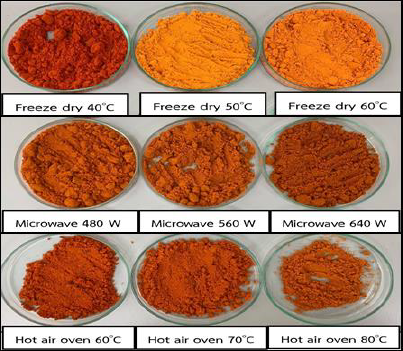ผลของวิธีและสภาวะการทำแห้งต่อปริมาณผลผลิตและสมบัติทาง เคมีกายภาพของเยื่อหุ้มเมล็ดฟักข้าวผง
คำสำคัญ:
เยื่อหุ้มเมล็ดฟักข้าว การทำแห้งแบบแช่เยือกแข็ง ไมโครเวฟ บีตา-แคโรทีน ไลโคปีนบทคัดย่อ
งานวิจัยนี้มีวัตถุประสงค์เพื่อศึกษาผลของวิธี (แช่เยือกแข็ง ไมโครเวฟ และลมร้อน) และสภาวะ (ต่ำ ปานกลาง และสูง) การทำแห้งต่อปริมาณผลผลิต บีตา-แคโรทีน และไลโคปีนในเยื่อหุ้มเมล็ดฟักข้าวผง ทำแห้งเยื่อหุ้มเมล็ดฟักข้าวด้วยเครื่องทำแห้งแบบแช่เยือกแข็งโดยแปรผันสภาวะการทำแห้ง ได้แก่ ต่ำ ปานกลาง และสูง (อุณหภูมิทำแห้งขั้นที่ 2 เท่ากับ 40 50 และ 60 องศาเซลเซียส) โดยความดันและระยะเวลาทำแห้งคงที่ เท่ากับ 0.05 มิลลิบาร์ และ 120 นาที ตามลำดับ ทำแห้งเยื่อหุ้มเมล็ดฟักข้าวด้วยเตาไมโครเวฟโดยแปรผันสภาวะการทำแห้ง ได้แก่ ต่ำ (กำลังไฟไมโครเวฟ เท่ากับ 480 วัตต์ นาน 15 นาที) ปานกลาง (กำลังไฟไมโครเวฟ เท่ากับ 560 วัตต์ นาน 13 นาที) และสูง (กำลังไฟไมโครเวฟ เท่ากับ 640 วัตต์ นาน 11 นาที) ทำแห้งเยื่อหุ้มเมล็ดฟักข้าวด้วยเตาอบลมร้อน แปรผันสภาวะการทำแห้ง ได้แก่ ต่ำ (อุณหภูมิลมร้อนเท่ากับ 60 องศาเซลเซียส นาน 540 นาที) ปานกลาง (อุณหภูมิลมร้อนเท่ากับ 70 องศาเซลเซียส นาน 480 นาที) และสูง (อุณหภูมิลมร้อนเท่ากับ 80 องศาเซลเซียส นาน 420 นาที) พบว่าการทำแห้งเยื่อหุ้มเมล็ดฟักข้าวแบบแช่เยือกแข็งที่สภาวะปานกลางและสูงทำให้มีปริมาณผลผลิต บีตา-แคโรทีน และไลโคปีนไม่แตกต่างกันอย่างมีนัยสำคัญ (p≥0.05) และมีค่ามากที่สุด การทำแห้งเยื่อหุ้มเมล็ดฟักข้าวแบบแช่เยือกแข็งที่สภาวะปานกลางใช้อุณหภูมิต่ำกว่าสภาวะสูง ทำให้ใช้พลังงานน้อยกว่าที่สภาวะสูง ดังนั้นสภาวะที่เหมาะสมสำหรับการทำแห้งเยื่อหุ้มเมล็ดฟักข้าว คือ การทำแห้งแบบแช่เยือกแข็งที่สภาวะปานกลาง (อุณหภูมิการทำแห้งขั้นที่ 2 เท่ากับ 50 องศาเซลเซียส) โดยมีปริมาณผลผลิตสูงที่สุด (ร้อยละ 21.46) ปริมาณบีตา-แคโรทีน และไลโคปีนสูงที่สุด (10.19 และ 1.98 mg/g น้ำหนักแห้ง ตามลำดับ)

ดาวน์โหลด
เผยแพร่แล้ว
ฉบับ
ประเภทบทความ
สัญญาอนุญาต
ลิขสิทธิ์ (c) 2021 วารสารวิทยาศาสตร์ประยุกต์

อนุญาตภายใต้เงื่อนไข Creative Commons Attribution-NonCommercial-NoDerivatives 4.0 International License.

